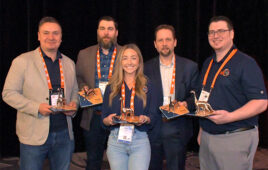The 2012 Additive Manufacturing Users Group (AMUG) conference included a number of informative sessions that I’ll be blogging about over the next few weeks. One session focused on inkjet 3D printing.
According to some at the conference, inkjetting is one of the most versatile forms of 3D printing. Multijet printing technology certainly lends credibility to the claim. The most versatile aspect of multijet printing is the ability to create materials, each with a different Shore harness, in addition to materials with differing levels of Shore hardness within each of them. General ink jet printing for 3D printer systems has undergone a number of improvements in recent years, among them: material throughput through the inkjet head is faster, you have greater control over the size of the droplets, and build speeds are faster.
The ability to create a material that will have different Shore hardness in various areas is intriguing. Dr. Ofer Shochet, Executive VP at Objet, gave a presentation at the recent AMUG conference, on Objet’s multi-jet technology. Noted Dr. Shochet, multijet printing (for Objet) is based on volumetric pixels (voxels). Objet engineers research materials by controlling the print head to deposit specific voxels to achieve specific mechanical properties, such as hardness, brittleness, flexibility, temperature resistance, and so on.
When the engineers have a reliable and predictable voxel combination, they release it as a material, such as VeroClear or VeroBlack. Information and specifications about each material’s performance are available on the Objet website.
In specific concentrations these Objet materials can provide pre-determined mechanical properties. Said Dr. Shochet, these are the Digital Materials, which are either homogeneous or geometry dependent. Homogeneous means that you can have different mixes, such as black and white, hard and flexible in a uniform distribution. You can create parts that are soft to the touch, that are shock absorbing or impact resistant, and so on.
Geometry dependent refers to how you arrange the droplets to obtain materials with different properties in various areas of the material. Dr. Shochet demonstrated this with the open source software, VoxCad. Objet developers use this program to simulate how different Digital Material combinations will intermingle and react. The program has an FEA engine that helps with the analysis. In the introductory video below, imagine each colored square is a particular Digital Material; You can see how this program would aid in the analysis and development of materials.
Perhaps you can also see how multijetting could be used to develop color-3Dprinted objects. While Objet gave a tantalizing glimpse into the possibility of color for its products at the Centre Pompidou demonstration several weeks ago, officially, it is not offering color printing yet.
Multi-jetting, though, can be used to help reduce the differences between some common prototyping materials. You can use geometry dependence to mimic the toughness of ABS for example. This technology is also good for developing temperature resistant materials. In some cases, Objet claims that you can replace laser sintered material with ABS-like materials. The engineers at Objet continually test new possible materials. As of this spring, they have 107 Digital Materials you can use.
Leslie Langnau
[email protected]
Note: this capability exists with the Connex line. The Eden line does not support multiple materials.
Filed Under: 3D printing • additive • stereolithography, Make Parts Fast




